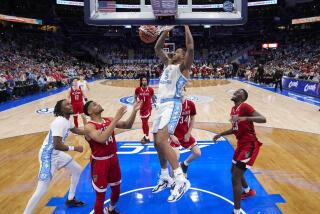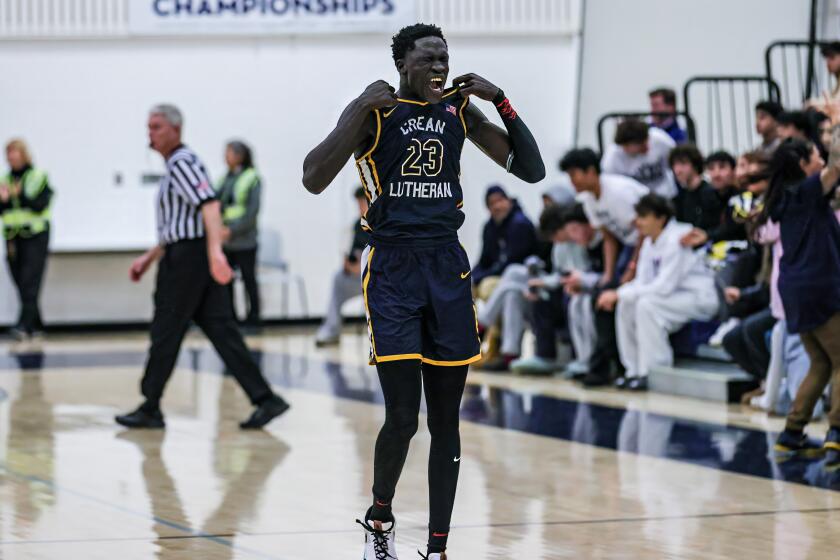Few surprises, or causes for complaint, in this NCAA bracket
- Share via
Weeks of nitpicking, handwringing, paralysis by analysis, bracket brain drain and pithy predictions gave way Sunday to the only bracket that matters.
The field of 68 was released to the masses and may we be the first to congratulate and console.
Ohio State, with no help needed from its athletic director, Gene Smith, this year’s NCAA selection committee chairman, ran away with the top overall seeding.
The Buckeyes are No. 1 in the East and will rock the Cleveland sub-regional Friday against a first-round winner (Alabama State/Texas San Antonio).
The chances of Ohio State’s moving on are excellent, considering that No. 1 owns a 104-0 all-time record against No. 16.
The other top-billing positions went to Kansas (Southwest), Pittsburgh (Southeast) and Duke (West).
Duke received a No. 1 seeding for the 12th time.
The Big East, as expected, landed a record 11 bids, the Big Ten got seven, and the Big 12 and Southeastern conferences received five each.
Welcome back these big-time programs: UCLA, North Carolina and Arizona, all left out last year, are all back in. The Bruins, Tar Heels and Wildcats have combined for 17 NCAA titles and 239 tournament victories.
UCLA went heels-up in the Pac-10 tournament but still ended up as No. 7 in the Southeast Regional and will face No. 10 Michigan State in Tampa, Fla., on Thursday. A first-round win pits the Bruins in a likely rematch against the Florida Gators.
UCLA’s recent NCAA history with Florida ended in “chomp, chomp,” with the Gators defeating the Bruins in the 2006 title game and then the next year knocking Westwood out in a national semifinal.
North Carolina, a team with the players and pedigree to make a serious run at this year’s title, is No. 2 in the East. Regular-season Pac-10 champion Arizona landed at No. 5 in the West and Pac-10 tournament champion Washington ended up No. 7 in the East.
Arizona’s first-round game against Memphis in Tulsa, Okla., will pit the Wildcats against one of their own, Coach Josh Pastner, a former UA player and assistant.
Surprises?
USC overcame bad early-season losses to Rider and Texas Christian and the recent suspension of its coach to sneak in as one of the last four at-large schools.
The Trojans will play a “first”-round game Wednesday in Dayton, Ohio, against Virginia Commonwealth, with the winner playing No. 6 Georgetown two days later in Chicago.
USC made the field only hours after Coach Kevin O’Neill was reinstated after serving a one-game suspension in the Pac-10 tournament stemming from an altercation with an Arizona fan.
Brigham Young, despite two lopsided losses since losing starter Brandon Davies to an honor code violation, still ended up as a No. 3 in the Southeast. The Cougars open against No. 14 Wofford in Denver.
USC and UCLA are not even the best teams in the field representing Southern California. That distinction goes to San Diego State, which wrapped up a No. 2 seeding in the West by defeating BYU for the Mountain West tournament championship.
The Aztecs (32-2), whose only losses this year came against BYU, open Thursday in Tucson against No. 15 Northern Colorado. It would be a major upset if San Diego State does not record its first NCAA tournament win in its seventh attempt.
The last time No. 15 toppled No. 2 was in 2001, when Hampton shocked Iowa State.
San Diego State’s second game would be against the winner of Temple versus Penn State, with the winner feeding into next week’s West Regional in Anaheim.
The at-large field was expanded by three this year, which gives schools less reason to gripe for not making it in.
There was still, though, the usual carping and heartbreak.
Those weren’t bells you were hearing at St. Mary’s, those were screams.
The Gaels (25-8) were one of last year’s best stories with their run to the Sweet 16, but an ugly loss to San Diego (not State) and two tough defeats to nemesis Gonzaga down the stretch cost St. Mary’s a spot in the field.
Colorado (21-13) was left behind despite three wins over Kansas State (in the field) and a win over Texas.
Virginia Tech (21-11), which always seems to be on the bubble and was left out last year, got the cold shoulder this year too.
And what about poor old Harvard Yard? The Ivy League has never received an at-large bid, but if ever there was a year . . . Harvard, which finished 23-6, with an RPI ranking of 35 and nonconference wins over Colorado and Boston College, lost the auto-bid to Princeton on a last-second shot.
How did Georgia (21-11) get in the field at the expense of Alabama (21-11), which beat Georgia twice this season?
Again, though, this is the wrong year to be looking for a sympathy card.
Seeding the field was another story.
Duke, the defending NCAA champion, ended up as the weakest No. 1 but appears to have the clearest path through the bracket. Why does this not shock legions of Duke haters? Only Hampton and the Michigan-Tennessee winner stand in the way of Duke cruising through Charlotte on its way to the Sweet 16 in Anaheim.
Ohio State, as the top overall No. 1, was slotted into a beast of an East. The regional also features No. 2 North Carolina, No. 3 Syracuse and No. 4 Kentucky.
Smith, the committee chair, couldn’t be in the room when his school was discussed, but he didn’t necessarily think the Buckeyes were disadvantaged.
“Sometimes we get caught up in brands,” he said of the other top schools in Ohio State’s bracket.
Well, yeah, North Carolina, Kentucky and Syracuse have combined for 13 national titles.
Most (at-first-glance) interesting opening games, all in the Southeast Regional: No. 6 St. John’s vs. No. 11 Gonzaga; No. 8 Butler vs. No. 9 Old Dominion; No. 13 Belmont vs. No. 4 Wisconsin.
Another clash of styles to note: No. 4 Kentucky vs. No. 13 Princeton in the East.
Yes, Princeton was a No. 13 in 1996 when it shocked No. 4 UCLA.
More to Read
Go beyond the scoreboard
Get the latest on L.A.'s teams in the daily Sports Report newsletter.
You may occasionally receive promotional content from the Los Angeles Times.











